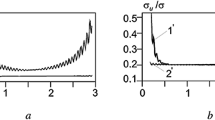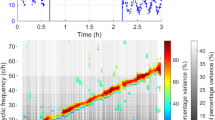Abstract
Mathematical methods are proposed for comparing the waveforms of signals with amplitudes distorted by unknown monotonic transformations and random noise. These methods are based on solving the problems of the best approximation of the signal under analysis to signals of a specified class and used in estimating the lag time of one fragment of signal with respect to another. Such problems arise, for example, in determining the direction of propagation of a sound wave in the atmosphere. The solution to this problem is based on the assumption that the conditions of the signal detection are different at different spatial points; as a result, the measured signals differ not only in their lag time, but also in nonlinear distortions, such that only the general waveform of the signal is preserved: if the amplitude of one signal is the result of a strictly monotonic transformation of the amplitude of another signal, then their waveforms are equivalent. In addition, the measurements are accompanied by an additive noise with an unknown dispersion.








Similar content being viewed by others
References
Averbuch, G., Assink, J. D., Smets, P. S. M., & Evers, L. G. (2018). Extracting low signal-to-noise ratio events with the Hough transform from sparse array data. Geophysics, 83, WC43-WC51. https://doi.org/10.1190/geo2017-0490.1.
Bai, X. (2007). Heat kernel analysis on graphs. Ph.D. Thesis, The University of York.
Belkin, M., & Niyogi, P. (2001). Laplacian eigenmaps and spectral techniques for embedding and clustering. Advances in Neural Information Processing Systems, 14, 585–591.
Brianskiy, S. A., Sidyakin, S. V., & Vizilter, Y. V. (2015). Orientation spectrum algorithm development. International Archives of the Photogrammetry, Remote Sensing and Spatial Information Sciences. https://doi.org/10.5194/isprsarchives-XL-5-W6-13-2015.
Coifman, R., & Lafon, S. (2006). Diffusion maps. Applied and Computational Harmonic Analysis, 21(1), 5–30.
Coifman, R., Lafon, S., Maggioni, M., Keller, Y., Szlam, A., Warner, F., et al. (2006). Geometries of sensor outputs, inference and information processing. Storage and Retrieval for Image and Video Databases. https://doi.org/10.1117/12.669723
Dougherty, E. R. (1989). The dual representation of gray-scale morphological filters. Computer Vision, Graphics, & Image Processing. https://doi.org/10.1109/CVPR.1989.37846.
de Goes, F., Goldenstein, S., & Velho, L. (2008). A hierarchical segmentation of articulated bodies. Computer Graphics Forum. http://dblp.unitrier.de/db/journals/cgf/cgf27.html\(\sharp\)GoesGV08
Gonzalez, R. C., & Woods, R. E. (2002). Digital Image Processing (2nd ed.). Upper Saddle River: Prentice-Hall.
Gori, M., Maggini, M., & Sarti, L. (2005). Exact and approximate graph matching using random walks. IEEE Transactions on Pattern Analysis and Machine Intelligence, 27, 1100–1111. https://doi.org/10.1109/TPAMI.2005.138.
Hough, P. V. C. (1962). Method and means for recognizing complex patterns (p. 3069654). Patent no.: US.
Huang, T. S. (1975). Picture Processing and Digital Filtering. Berlin: Springer.
Hussain, M., Chen, D., Cheng, A., Wei, H., & Stanley, D. (2013). Change detection from remotely sensed images: From pixel-based to objectbased ap-proaches. ISPRS Journal of Photogrammetry and Remote Sensing, 80, 91–106.
Kulichkov, S. N., Chulichkov, A. I., & Demin, D. S. (2011). On experience in using the method of morphological data analysis in atmospheric acoustics. Izvestiya, Atmospheric and Oceanic Physics, 47, 154–165. https://doi.org/10.1134/S000143381102006X.
Kulichkov, S. N., Tsybulskaya, N. D., Chunchuzov, I. P., Gordinb, V. A., Bykovb, Ph L, & Chulichkova, A. I. (2017). Studying internal gravity waves generated by atmospheric fronts over the Moscow region. Izvestiya, Atmospheric and Oceanic Physics, 53, 402–412. https://doi.org/10.1134/S0001433817040077.
La, S., Chandra, M., Upadhyay, G. K., & Gupta, D. (2011). Removal of additive Gaussian noise by complex double density dual tree discrete wavelet transform. MIT International Journal of Electronics and Communication Engineering, 1(1), 8–16.
Lafon, S., Keller, Y., & Coifman, R. R. (2006). Data fusion and multicue data matching by diffusion maps. IEEE Transactions on Pattern Analysis and Machine Intelligence, 28, 1784–1797. https://doi.org/10.1109/TPAMI.2006.223.
Lafon, S. (2004). Diffusion maps and geometric harmonics. Ph.D. Thesis, Department of Mathematics and Applied Mathematics, Yale University.
Mohideen, S. K. (2012). Denoising of images using complex wavelet transform. International Journal of Advanced Scientific and Technical Research, 1(2), 176–184.
Pyt’ev, Yu P. (1993). Morphological image analysis. Pattern Recognition Image Analysis, 3, 19–28.
Pyt’ev, Yu P. (1997). The morphology of color (multispectral) images. Pattern Recognition Image Analysis, 7, 467–473.
Pyt’ev, Yu P. (1998). Methods of morphological analysis of color images. Pattern Recognition Image Analysis, 8, 517–531.
Pyt’ev, Yu P, Kalinin, A. V., Loginov, E. O., & Smolovik, V. V. (1998). On the problem of object detection by black-and-white and color morphologies. Pattern Recognition Image Analysis, 8, 532–536.
Pyt’ev, Yu P, & Zhivotnikov, G. S. (2004). On the methods of possibility theory for morphological image analysis. Pattern Recognition Image Analysis, 14, 60–71.
Pyt’ev, Yu P, & Chulichkov, A. I. (2010). Methods of Morphological Image Analysis. Moscow: Fizmatlit. (in Russian).
Serra, J. (1982). Image Analysis and Mathematical Morphology. London: Academic Press.
Urbach, E. R., Roerdink, J. B., & Wilkinson, M. H. (2007). Connected shape-size pattern apectra for rotation and scale-invariant classification of gray-scale images. IEEE Transactions on Pattern Analysis and Machine Intelligence, 29(2), 272–285.
Vizilter, Yu V, Gorbatsevich, V. S., Rubis, A Yu., & Zheltov, S Yu. (2014). Shape-based image matching using heat kernels and diffusion maps. International Archives of the Photogrammetry, Remote Sensing and Spatial Information Sciences, 40, 357. https://doi.org/10.5194/isprsarchives-XL-3-357-2014.
Zhivotnikov, G. S., Pyt’ev, Yu P, & Falomkin, I. I. (2005). On the filtering algorithm for images. Pattern Recognition Image Analysis, 3(1), 19–28.
Acknowledgements
This work was supported by the Russian Foundation for Basic Research (projects nos. 17-07-00832 and 18-05-00576) and the program of the Presidium of Russian Academy of Science no. 56.
Author information
Authors and Affiliations
Corresponding author
Rights and permissions
About this article
Cite this article
Chulichkov, A.I., Kulichkov, S.N., Tsybulskaya, N.D. et al. Comparing Signal Waveforms and Their Use in Estimating Signal Lag Time. Pure Appl. Geophys. 176, 335–344 (2019). https://doi.org/10.1007/s00024-018-2056-x
Received:
Revised:
Accepted:
Published:
Issue Date:
DOI: https://doi.org/10.1007/s00024-018-2056-x




